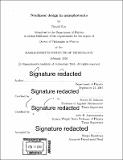| dc.contributor.advisor | Steven G. Johnson and John D. Joannopoulos. | en_US |
| dc.contributor.author | Liu, David, Ph. D. Massachusetts Institute of Technology | en_US |
| dc.contributor.other | Massachusetts Institute of Technology. Department of Physics. | en_US |
| dc.date.accessioned | 2016-06-22T17:49:42Z | |
| dc.date.available | 2016-06-22T17:49:42Z | |
| dc.date.copyright | 2016 | en_US |
| dc.date.issued | 2016 | en_US |
| dc.identifier.uri | http://hdl.handle.net/1721.1/103229 | |
| dc.description | Thesis: Ph. D., Massachusetts Institute of Technology, Department of Physics, 2016. | en_US |
| dc.description | Cataloged from PDF version of thesis. | en_US |
| dc.description | Includes bibliographical references (pages 165-181). | en_US |
| dc.description.abstract | In the first part of this thesis, we present a new technique for the design of transformation optics devices based on large-scale optimization to achieve the optimal effective isotropic dielectric materials within prescribed index bounds. In addition to the optimization, a key point is the identification of the correct boundary conditions to ensure reflectionless coupling to untransformed regions while allowing maximum flexibility in the optimization. We apply our technique to the design of multimode waveguide bends and mode squeezers, in which all modes are transported equally without scattering. In the second part of this thesis, we introduce a direct, efficient, and flexible method for solving the non-linear lasing equations of the steady-state ab initio laser theory (SALT). We validate this approach in one-dimensional as well as in cylindrical systems, and demonstrate its scalability to full-vector three-dimensional calculations in photonic-crystal slabs. Our method paves the way for efficient and accurate simulations of micro lasers which were previously inaccessible. In the third part of this thesis, we introduce a theory of degenerate lasing modes based on SALT. We present an analytical method to determine the stable superposition of lasing modes, and also a numerical method for cases in which the degeneracy is un physically broken by the discretization. We demonstrate these ideas in examples such as a uniform dielectric cylinder, a metallic rectangular cavity, and a hexagonal cavity made of air holes. | en_US |
| dc.description.statementofresponsibility | by David Liu. | en_US |
| dc.format.extent | 181 pages | en_US |
| dc.language.iso | eng | en_US |
| dc.publisher | Massachusetts Institute of Technology | en_US |
| dc.rights | M.I.T. theses are protected by copyright. They may be viewed from this source for any purpose, but reproduction or distribution in any format is prohibited without written permission. See provided URL for inquiries about permission. | en_US |
| dc.rights.uri | http://dspace.mit.edu/handle/1721.1/7582 | en_US |
| dc.subject | Physics. | en_US |
| dc.title | Nonlinear design in nanophotonics | en_US |
| dc.type | Thesis | en_US |
| dc.description.degree | Ph. D. | en_US |
| dc.contributor.department | Massachusetts Institute of Technology. Department of Physics | |
| dc.identifier.oclc | 951539899 | en_US |
